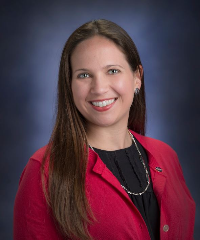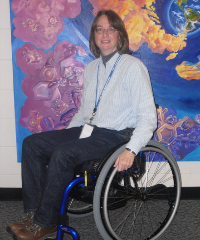GISN & STEM Professional's Blog - GLOBE International STEM Network
GISN & STEM Professional's Blog
The GLOBE International STEM Network (GISN) and STEM Professional's Blog is an online collaborative effort where scientists associated with GLOBE post their thoughts, comments, and philosophies about a variety of science topics.
GLOBE strongly encourages positive and productive discussions to further advance the scientific understanding of all involved with The GLOBE Program.
Filter By:
Blogs List
The Urban Heat Island Effect Intensive Observation Period (IOP) has started. The weather in the Northern Hemisphere has started to get warmer as meteorological spring started March 1. There was an amazing weather situation where I live this past Saturday. You can see in the images on the left that I drove about 20 miles (32 km) from my house in Michigan to the Oak Openings Park in Ohio. There is a warm front stalled across the area.
It was near 40 F (6 C) near my house but in the upper 60s (20 C) at the park. You can see in the right image that there was a warm front between my house ...
Read More »
Posted in:
In the Toledo area, Dr. C and schools in the area focused on studying artificial turf versus grass soccer and football fields. Artificial turf was much warmer than natural grass. This is combining the GLOBE Urban Heat Island Field Study with research by Vasco Mantas from the University of Coimbra in Portugal and George Xian from the USGS Eros Data Center and the AREN Project with Andy Henry and Geoff Bland.
University of Toledo students using the AREN TerraROVER on the UT football field.
You can see that the artificial turf of the football field (called the Glass Bowl) and the ...
Posted in:
Field Campaigns:
SURFACE TEMPERATURE
Investigation Areas:
SURFACE TEMPERATURE
Student Research Reports:
U.S. STUDENT RESEARCH SYMPOSIA (SRS)
MISSION EARTH REPORT
Did you know that clouds can both warm and cool our planet? Keeping an eye on clouds helps NASA study our climate. You can notice some of these changes by just looking at the clouds.
Here are some examples you might have already noticed:
Do all clouds cast shadows? Low thick clouds tend to cast the most shadows. The shadows show you how the cloud is blocking the light from the sun from reaching the ground. This is similar to you placing your hand in front of your eyes when it is too sunny. Your hand is blocking the light from reaching your eyes. This is the same as the ...
Posted in:
Curriculum:
SCIENCE AND MATH
STEM
GLOBE Science Topics:
BACKYARD SCIENCE
CLIMATE
CLIMATE CHANGE
GENERAL SCIENCE
GLOBE PROTOCOLS
EARTH AS A SYSTEM
SCIENTIST SKILLS
Investigation Areas:
ATMOSPHERE
Primary Audience:
ALUMNI
COUNTRY COORDINATORS
PARTNERS
SCIENTISTS
STUDENTS
TEACHERS
TRAINERS
The weather has been really kicking up quite a bit of whacky weather in November. On November 2, 2021, the town of Kikonai in northern Japan’s Kokkaido prefecture set a record amount of rainfall of 2.2 inches (5.5 centimeters) in 10 minutes. Wow!! That’s a lot of rain in a short amount of time! You can see where the rainfall fell on the image below!
(credit: Extreme weather around the world amid COP26 - The Washington Post )
Meanwhile in Uzbekistan, it saw the worst dust storm in about 50 years! The dust finally settled on November 4, 2021 but ...
Posted in:
Investigation Areas:
ATMOSPHERE
EARTH AS A SYSTEM
Stratus clouds are one of the three main types of clouds. Remember that there are many types of clouds that fall into three main categories: cumulus, stratus, and cirrus. Using hand-motions , we would stretch out our hands as far out as we could to mimic a stratus cloud. There are stratus-type clouds at all three basic altitude levels. These are: stratus clouds (low level), altostratus clouds (mid level), and cirrostratus clouds (high level). When stratus-type clouds are present, your skies will most likely be overcast or the cloud cover is 90% or more. Note, there is a ...
Posted in:
Curriculum:
SCIENCE AND MATH
STEM
GLOBE Science Topics:
GENERAL SCIENCE
GLOBE PROTOCOLS
Investigation Areas:
ATMOSPHERE
EARTH AS A SYSTEM
Primary Audience:
ALUMNI
COUNTRY COORDINATORS
PARTNERS
STUDENTS
TEACHERS
TRAINERS
Have you heard there is a new clouds project? It is called NASA GLOBE CLOUD GAZE. It is a merger of GLOBE Clouds and The Zooniverse online citizen science platform. A one-week pacing guide is now available!
Sky photographs are one of the most requested portions of a GLOBE Clouds observation. This is because there is so much you can do with them. Photographs give scientists the opportunity to be right there with you. Details within a photograph can be used to compare with satellite data, confirm dust or haze observations, and give insight to unique cloud types like ...
Posted in:
Curriculum:
SCIENCE AND MATH
STEM
GLOBE Science Topics:
BACKYARD SCIENCE
CLIMATE
CLIMATE CHANGE
DATA INCLUDED
GENERAL SCIENCE
GLOBE PROTOCOLS
EARTH SYSTEM SCIENCE
Investigation Areas:
ATMOSPHERE
Learning Activities:
ATMOSPHERE AND CLIMATE
News Topics:
NEWS BRIEFS
Primary Audience:
ALUMNI
COUNTRY COORDINATORS
PARTNERS
SCIENTISTS
STUDENTS
TEACHERS
TRAINERS
At the start of the month, i was invited by SAASTA, a body in South Africa that promotes science in schools to train teachers in 4 districts in 4 days in Mpumalanga. It took me 5hrs of drive from Pretoria to my first venue of training where 40 teachers from different schools welcomed us. Later on we proceeded to two other districts where at least 40 teachers at each venue were introduced to GLOBE, trained in two Atmospheric protocols, how to navigate the website, enter data and shown how to use the GLOBE observer App. The six hour day training empahasised the importance of intergrating ...
Posted in:
GLOBE Working Groups:
EDUCATION WORKING GROUP
Primary Audience:
TRAINERS
Many protocol-trained GLOBE members may have noticed a recent update to the GLOBE Program’s GLOBE Observer app. The change brings a new look and a new way to submit GLOBE atmospheric measurements. If you were used to entering meteorological conditions in the Cloud Tool, you’ll see this option is no longer there. Don’t worry, you can still submit these observations through the Atmosphere Data Entry section. You just need to do a few extra steps to get it all set up. The new update gives you the opportunity to save your favorite or go to observations as a bundle, a step you ...
Posted in:
GLOBE Science Topics:
CLIMATE
CLIMATE CHANGE
DATA INCLUDED
GENERAL SCIENCE
GLOBE PROTOCOLS
Investigation Areas:
ATMOSPHERE
EARTH AS A SYSTEM
Primary Audience:
ALUMNI
COUNTRY COORDINATORS
PARTNERS
TEACHERS
TRAINERS
Every time you take a cloud observation, the NASA GLOBE Clouds team matches your observation to satellite data. Why do we do this? Your view of clouds is from a different perspective than what is observed from a satellite. Satellites look down at clouds and see the top. When you make your observation, you are looking up towards the sky and seeing the bottom of the clouds. When there is a match, scientists then have a top-down view of clouds from a satellite and a bottom-up view from your spot. When you mix these two views together, you have a more complete picture of the sky. ...
Posted in:
Curriculum:
EDUCATION RESEARCH
SCIENCE AND MATH
STEM
GLOBE Science Topics:
BACKYARD SCIENCE
CLIMATE
CLIMATE CHANGE
DATA INCLUDED
GENERAL SCIENCE
GLOBE PROTOCOLS
EARTH AS A SYSTEM
EARTH SYSTEM SCIENCE
SCIENTIST SKILLS
Investigation Areas:
ATMOSPHERE
EARTH AS A SYSTEM
News Topics:
REGIONS
Primary Audience:
ALUMNI
COUNTRY COORDINATORS
PARTNERS
SCIENTISTS
STUDENTS
TEACHERS
TRAINERS
The NASA GLOBE Clouds team highlights cloud observers Hilde Fålun Strøm (Norway) and Sunniva Sorby (Canada), who created Hearts In The Ice to call attention to all the rapid changes occurring in the polar regions due to the changing climate. These citizen scientists made history last year by being the first women to overwinter solo in the high Arctic. They spent 12 consecutive months without running water or electricity at a remote trappers cabin called “Bamsebu” in Svalbard, Norway. While they were there, they made numerous GLOBE cloud observations as ...
Posted in:
Curriculum:
LANGUAGE CULTURE AND ARTS
STEM
GLOBE Science Topics:
BACKYARD SCIENCE
CLIMATE
CLIMATE CHANGE
DATA INCLUDED
GENERAL SCIENCE
EARTH AS A SYSTEM
EARTH SYSTEM SCIENCE
SCIENTIST SKILLS
GLOBE Working Groups:
SCIENCE WORKING GROUP
EDUCATION WORKING GROUP
Investigation Areas:
ATMOSPHERE
EARTH AS A SYSTEM
News Topics:
COMMUNITY LETTERS
NEWS BRIEFS
Primary Audience:
ALUMNI
COUNTRY COORDINATORS
PARTNERS
SCIENTISTS
STUDENTS
TEACHERS
TRAINERS
The NASA GLOBE Clouds team is continuously working with scientists around the world finding ways that cloud observations from citizen scientists impact the most. As we find new ways of using the data, we want to remind you how important each part of your cloud report is to the scientific community. All cloud observations can help with big questions such as the link between clouds and climate. Dr. Patrick Taylor is an atmospheric scientist at NASA Langley Research Center in Hampton, Virginia. In the Clouds and Earth’s Climate video , Patrick discusses how he studies clouds to ...
Posted in:
Curriculum:
ASSESSMENT AND EVALUATION
EDUCATION RESEARCH
SCIENCE AND MATH
STEM
GLOBE Science Topics:
BACKYARD SCIENCE
CLIMATE
CLIMATE CHANGE
GENERAL SCIENCE
GLOBE PROTOCOLS
EARTH AS A SYSTEM
EARTH SYSTEM SCIENCE
SCIENTIST SKILLS
GLOBE Working Groups:
SCIENCE WORKING GROUP
EDUCATION WORKING GROUP
Investigation Areas:
ATMOSPHERE
EARTH AS A SYSTEM
Learning Activities:
ATMOSPHERE AND CLIMATE
News Topics:
COMMUNITY LETTERS
NEWS BRIEFS
Primary Audience:
ALUMNI
COUNTRY COORDINATORS
PARTNERS
SCIENTISTS
STUDENTS
TEACHERS
TRAINERS
Student Research Reports:
STANDARD RESEARCH REPORT
Teacher's Guide:
INVESTIGATION AREA DOCUMENTS
Each cloud observation submitted using the GLOBE Observer app or through The GLOBE Program is compared to data from multiple satellites. A satellite match is when satellite data is identified that corresponds to a cloud observation. For orbiting satellites the observation must be within 15 minutes before or after a satellite’s overpass. Geostationary satellites, like the GOES satellites, are always observing the same location. If you are in the United States, you are likely to get a satellite match to a GOES satellite. These satellites are sending data every 15 minutes. As long ...
Posted in:
Curriculum:
SCIENCE AND MATH
STEM
GLOBE Science Topics:
BACKYARD SCIENCE
CLIMATE
GENERAL SCIENCE
GLOBE PROTOCOLS
EARTH AS A SYSTEM
EARTH SYSTEM SCIENCE
SCIENTIST SKILLS
Investigation Areas:
ATMOSPHERE
EARTH AS A SYSTEM
News Topics:
COMMUNITY LETTERS
NEWS BRIEFS
Primary Audience:
ALUMNI
COUNTRY COORDINATORS
PARTNERS
SCIENTISTS
STUDENTS
TEACHERS
TRAINERS
The NASA GLOBE Clouds team at NASA Langley Research Center is working with NASA scientist Dr. Bill Smith to use GLOBE Cloud observations made by people just like you to solve the Terminator Problem!
Wait, what? Well, the Solar Terminator or twilight zone is that line that separates the daylit side of a planet from the dark night side. The image on the left is an example. It was taken from the International Space Station as it crossed the terminator on April 17, 2019 as it orbits 254 miles above the Gulf of Guinea on Africa’s mid-western coast.
...
Posted in:
Curriculum:
EDUCATION RESEARCH
SCIENCE AND MATH
TECHNOLOGY
STEM
GLOBE Science Topics:
BACKYARD SCIENCE
CLIMATE
CLIMATE CHANGE
DATA INCLUDED
GENERAL SCIENCE
GLOBE PROTOCOLS
EARTH AS A SYSTEM
EARTH SYSTEM SCIENCE
SCIENTIST SKILLS
Investigation Areas:
ATMOSPHERE
EARTH AS A SYSTEM
Learning Activities:
ATMOSPHERE AND CLIMATE
EARTH AS A SYSTEM
News Topics:
COMMUNITY LETTERS
NEWS BRIEFS
Student Research Reports:
STANDARD RESEARCH REPORT
INTERNATIONAL VIRTUAL SCIENCE SYMPOSIUM REPORT
U.S. STUDENT RESEARCH SYMPOSIA (SRS)
In May 2020, citizen scientist Carmen Mandel met two major milestones: she marked her one-year anniversary of being a GLOBE Observer and she single-handedly expanded the Clouds satellite match data by 36%. Carmen uses GLOBE Observer to record clouds 2-3 times daily every time she gets a notification that a NASA satellite is overhead. She sends her data to GLOBE, but then she records her observation in her own clouds journal. When she receives an email from NASA Langley Research Center matching her observation to satellite data, she adds that to her journal as ...
Posted in:
GLOBE Science Topics:
BACKYARD SCIENCE
DATA INCLUDED
EARTH SYSTEM SCIENCE
GENERAL SCIENCE
Investigation Areas:
ATMOSPHERE
CLOUDS
Primary Audience:
ALUMNI
COUNTRY COORDINATORS
SCIENTISTS
STUDENTS
Images taken by Wilson Bentley and property of the Jericho Historical Society.
Did you know that clouds have names? As the title of the GLOBE Elementary book says, clouds do have names. Those names describe the altitude and the appearance of the cloud. Cumulus means pile in Latin, so the name is used to describe low puffy clouds in the sky. Cirrus means locks of hair, and is used to describe those thin wispy clouds found high up in the sky. Some people think that nimbus is a type of cloud, but it is not. It is an affix, or a word that works as a prefix or a suffix. ...
Posted in:
Curriculum:
ASSESSMENT AND EVALUATION
GLOBE Science Topics:
BACKYARD SCIENCE
Investigation Areas:
ATMOSPHERE
Learning Activities:
ATMOSPHERE AND CLIMATE
News Topics:
COMMUNITY LETTERS
Primary Audience:
ALUMNI
Lectures, lessons, and learning opportunities of all kinds are available online these days… luckily, air quality investigations can be, too! Publically available sources of air quality data, which can be accessed any time and anywhere, can be used in conjunction with or in lieu of the GLOBE Aerosols Protocol for students and teachers participating in the US Air Quality Student Research Campaign. This blog post will introduce a website which can be used to conduct air quality investigations with a ground-based instrument, called the PurpleAir.
The PurpleAir is a small, commercially ...
Posted in:
Lectures, lessons, and learning opportunities of all kinds are available online these days… luckily, air quality investigations can be, too! Publically available sources of air quality data, which can be accessed any time and anywhere, can be used in conjunction with or in lieu of the GLOBE Aerosols Protocol for students and teachers participating in the US Air Quality Student Research Campaign. This blog post will introduce a website called AerosolWatch, an online access point for satellite-based observations of aerosols, and factors that affect air quality (such as smoke and dust). ...
Posted in:
It snowed at my house in Michigan last week, the first week of December 2020. I love snow and I really like to see how snow affects the surface temperature. Between 60 and 80 mm of snow was on the ground. I took surface temperature observations as part of the Urban Heat Island Student Research Campaign. I wanted to show what you could do by yourself at your house if you have an infrared thermometer.
My two sites are my backyard which is grass and the gravel driveway in the front of our house. The backyard has a line of Black Spruce trees just south of where I am standing in the ...
Posted in:
Field Campaigns:
SURFACE TEMPERATURE
Scientists are wondering what is happening over Antarctica and where are the noctilucent clouds. Noctilucent clouds or polar mesospheric clouds are the highest occurring cloud types (form about 50 miles or 80 Km above the Earth's surface). They form in the Mesosphere and are thin clouds made up of ice crystals that form from left over fine dust from meteors. Because they are so high up in the sky, you see them when the sun is low or almost nighttime. The form during the summer months over the north and south poles. That is when it is coldest that high up in the sky ( in the mesosphere ...
Posted in:
GLOBE Science Topics:
CLIMATE
CLIMATE CHANGE
Investigation Areas:
ATMOSPHERE
EARTH AS A SYSTEM
Primary Audience:
ALUMNI
COUNTRY COORDINATORS
PARTNERS
SCIENTISTS
STUDENTS
TEACHERS
TRAINERS
Even with the pandemic, participation the campaign has been good. Although the number of schools participating and the total number of observations was down from last year, it was still a nice number of each. So far this fall (Northern Hemisphere) spring (Southern Hemisphere) there have been over 3,500 observations from 135 sites (70 schools) across the world. Please see the list below. There are a number of schools in Saudi Arabia with over 100 observations. We also have observations from Brazil and an area of India where there are six new schools taking part in the urban heat island ...
Posted in:
Field Campaigns:
SURFACE TEMPERATURE
—
20 Items per Page









